You are using an out of date browser. It may not display this or other websites correctly.
You should upgrade or use an alternative browser.
You should upgrade or use an alternative browser.
[BUILD] GIX-51X tube preamp
- Thread starter gemini86
- Start date
Help Support GroupDIY Audio Forum:
This site may earn a commission from merchant affiliate
links, including eBay, Amazon, and others.
gemini86
Well-known member
Alpha, lorlin, and I think there's a C&K switch also. At least in their catalog, none of them come in a shorting round shaft with PC pins. It's just as easy to clip the solder lugs off though. (I had to do this for one of my channels.)
EDIT:
The part number for the MBB (shorting) switch, with PC pins and a flated D shaft should be CK1054.
again, if you're using standard set screw knobs, this will work fine. Collet knobs, I have no clue.
EDIT:
The part number for the MBB (shorting) switch, with PC pins and a flated D shaft should be CK1054.
again, if you're using standard set screw knobs, this will work fine. Collet knobs, I have no clue.
couple quick questions....
Will this work in an API 500 series lunchbox type of unit or strictly -/+ 24 VDC only?
Has the BOM been finaized and corrected with all the proper parts?
Can someone who has already built the unit give me an estimate of what the BOM will cost? I'm trying to figure out how much this Pre will cost with all the materials?
Thanks
G
Will this work in an API 500 series lunchbox type of unit or strictly -/+ 24 VDC only?
Has the BOM been finaized and corrected with all the proper parts?
Can someone who has already built the unit give me an estimate of what the BOM will cost? I'm trying to figure out how much this Pre will cost with all the materials?
Thanks
G
gemini86
Well-known member
I suppose I should get around to getting the BOM situated... sorry, life has a way of keeping me busy doing stupid stuff lately.
I'm gonna start sorting it all out so all the info is in one place on the first post.
But to answer your question, this preamp was designed to run on +/-24V. There was a brief discussion earlier in this thread about converting it to 16V operation. It's definitely possible, but has not been tried yet.
Build cost is pretty straight forward for your small passive components, then there's your choice of tubes with is a big variable, then there's the iron. I myself like the OPE input, but I'm having second thoughts about the OEP output. I think this preamp would sound much better, bigger low end, less muddy mids if it had something with a larger core. Many like the Lundahl transformers, but they're too spendy for me. I'm going to put some edcor xs1100 transformers in mine soon, which edcor advertises as being an LL5402 substitute. I doubt they're in the same league, but for the money, you can't go wrong.
I'm gonna start sorting it all out so all the info is in one place on the first post.
But to answer your question, this preamp was designed to run on +/-24V. There was a brief discussion earlier in this thread about converting it to 16V operation. It's definitely possible, but has not been tried yet.
Build cost is pretty straight forward for your small passive components, then there's your choice of tubes with is a big variable, then there's the iron. I myself like the OPE input, but I'm having second thoughts about the OEP output. I think this preamp would sound much better, bigger low end, less muddy mids if it had something with a larger core. Many like the Lundahl transformers, but they're too spendy for me. I'm going to put some edcor xs1100 transformers in mine soon, which edcor advertises as being an LL5402 substitute. I doubt they're in the same league, but for the money, you can't go wrong.
I'd be interested in this build but I know there are 2 things that would deter that interest a bit. For one, I have already decided on a radial engineering six pack power rack which I believe is only 16 VDC 500 series but the feature set is second to none for the price and what you get even the cube power rack. SO that is why 16VDC is important to me.
Second, I'm new to DIY but I have a few builds under my belt. With that said, when I run across post that have many changes or testing in progress or updates I get confused easily.
In this instance it seems many test and updates were discovered along the way so I only want to order once when it is time to build the BOM.
Any time frame on when the BOM might be updated?
Thanks G
Second, I'm new to DIY but I have a few builds under my belt. With that said, when I run across post that have many changes or testing in progress or updates I get confused easily.
In this instance it seems many test and updates were discovered along the way so I only want to order once when it is time to build the BOM.
Any time frame on when the BOM might be updated?
Thanks G
gemini86
Well-known member
Bruce0 did a great job of testing the DC boost converter, basically dissecting it. He wanted to see what made it tick. After trying a few other variants, the original design was kept it works great. The one addition was a 100n cap on the converter controller's feedback pin to filter noise and stabilize the HV output.
Now, given that you're using 16V rails, you'll have two major problems to overcome. First being that the tube filaments are wired in series for 24V rails. Even when you wire them in parallel for 12V operation, they will consume 12V @ 300mA. The max spec per 500 slot is 130mA, I believe. So you're going to use up more than 2 rack spaces on one preamp (in the way of power supply). Secondly, the HV boost converter is designed to run on 24V. It uses about 120mA on the +24V rail, and would use even more when run on 16V rails.
So your 6 pack will quickly fill up if you try to adapt these to 500 series spec. OR, you can upgrade your power supply to handle the extra load.
These would also go nicely into a 1U 19" rack enclosure.
I hope that gives some sort of insight. I'll try to have the BOM straightened out by the end of the week maybe.
Now, given that you're using 16V rails, you'll have two major problems to overcome. First being that the tube filaments are wired in series for 24V rails. Even when you wire them in parallel for 12V operation, they will consume 12V @ 300mA. The max spec per 500 slot is 130mA, I believe. So you're going to use up more than 2 rack spaces on one preamp (in the way of power supply). Secondly, the HV boost converter is designed to run on 24V. It uses about 120mA on the +24V rail, and would use even more when run on 16V rails.
So your 6 pack will quickly fill up if you try to adapt these to 500 series spec. OR, you can upgrade your power supply to handle the extra load.
These would also go nicely into a 1U 19" rack enclosure.
I hope that gives some sort of insight. I'll try to have the BOM straightened out by the end of the week maybe.
mulletchuck
Well-known member
Toure14, you'll just waste slots if you try to run it in a 16V box, and cuz you'll have to cut traces and whatnot as well. it's PHYSICALLY designed to fit into the 18slot connector of 51x. Every lunchbox clone out there is 16V and uses the 15-pin slot connector. GroupDIY 51x is the only thing that uses 18pin connectors and a pair of 24V rails in addition to everything else that is built in to the VPR (500-series) spec. Don't waste your time with the Radial box if you are serious about this particular project. just hit up Jeff/Sahib/Volker for the 11slot 51x chassis and PSU and be done with it. it's like 700USD for everything.
I've decided to go with the 51x rack but I'll still look for an alternative to a 1 slot or maybe 2 slot power supply. Something like what chunger built in the build thread for the first generation PSU for ths rack. Then I'll still have to figure out some cosmetic stuff to make it mobile. too bad I can't just swap out the board inside the Radial Engineering workhorse six-pack. That would be so perfect plus I get all the built in features.
gemini86
Well-known member
Welcome to diy, you can implement those features you need into your own rack, with a bit of creativity and some hand wiring.
yeah the DIY part is cool for those who have the hand tools and workstations but for someone like me who is generally good at building from an already tested design, DIY can tend to be expensive and challenging...frustrating.
It's like knowing what you want in your head but not having he resources to build it. I'll give it a shot though.
Now if only someone had a Radial Engineering Cube I could disassemble... :
It's like knowing what you want in your head but not having he resources to build it. I'll give it a shot though.
Now if only someone had a Radial Engineering Cube I could disassemble... :
gemini86
Well-known member
Updated first post:
- Schematic with bruce0's filter mod and the HV converter "Rodney" cap mod.
- Updated BOM to include the (hopefully) correct gain switch part # and added components for the filter and converter cap.
gemini86
Well-known member
So, anyone else have some show and tell? Who's building these? Or are you all hoarders, like me?
I had a slight detour to build a test signal driver that could drive RightMark tests through these both in Mic and Line mode, but I now have four units in test.
2 with Lundahl input and output
1 with OEP input and Output
1 with Cinemag Input and OEP output
Here are the 4 racked up for testing (Show and tell)
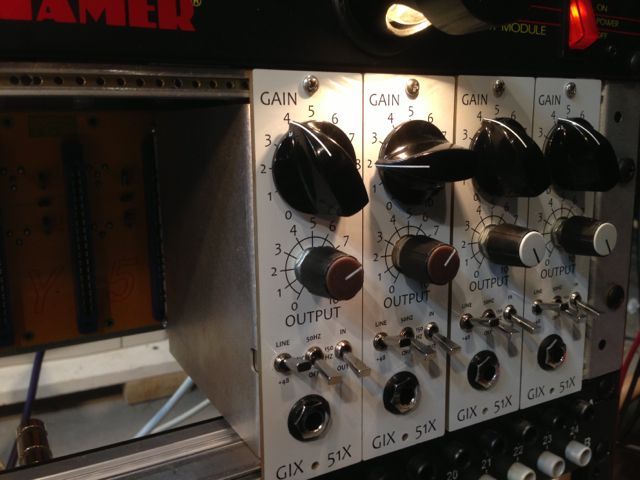
I wanted to verify my ears for the additional HT PSU filtering I thought was necessary, and I was able to measure a 8dB improvement in RMS noise measured with the additional filtering.
In most of my testing I found that the little Metal Shields I built for the power supplies make no detectable difference (they ranged from 0.6dB better to 0.2dB worse!) or at least not a difference that was repeatable in my test environment. That was until I tried the Cinemag input transformer.
As you can see from this picture, the Cinemag sits closer to the power supply than the other transformers. When testing with the Cinemag (using RightMark RMAA through a USB sound interface and my test interface) I see 3dB lower noise on with the shield in place. But I can ONLY measure this on the Cinemag (I think because it so close to the HT power supply).
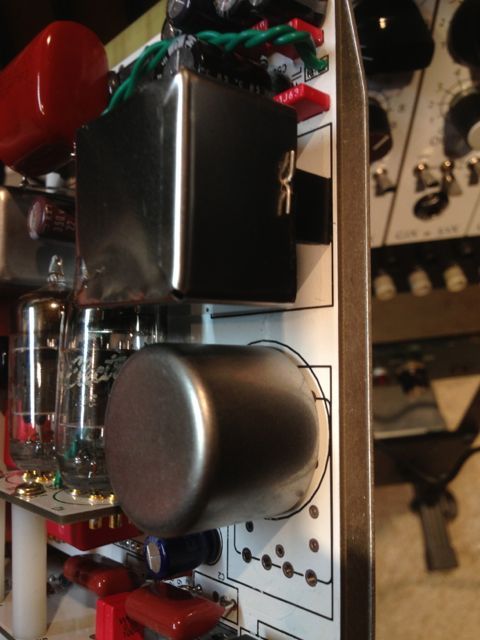
Other testing conforms to what folks see on the Gyraf G9. I was seeing a pretty substantial low end rolloff on all the units until I tried one with an old Altec input transformer, and then I got a Cinemag input transformer and again it had less rolloff (at 20Hz I was seeing it down 10db, with the OEP and Lundahl input transformers, with the Cinemag it is about 3dB down).
Sure enough if I drive the test interface through the Guitar/DI input on the front I don't get the big rolloff either, so I am pretty sure the input transformers are involved.
There are posts about this on the Gyraf board, and my measurements match the ones there pretty close, but they speak of different OUTPUT transformers. What I am seeing is that the input transformer can effect the low end (I assume because in Line mode the input transformer is still in the path).
I also see a bit of a high end response peak on the OEP.
In any case Jacob warns on the G9 board that it is important to test with your ears, so I think it is time I get these into use and hear what they can do. They test out quiet enough.
2 with Lundahl input and output
1 with OEP input and Output
1 with Cinemag Input and OEP output
Here are the 4 racked up for testing (Show and tell)

I wanted to verify my ears for the additional HT PSU filtering I thought was necessary, and I was able to measure a 8dB improvement in RMS noise measured with the additional filtering.
In most of my testing I found that the little Metal Shields I built for the power supplies make no detectable difference (they ranged from 0.6dB better to 0.2dB worse!) or at least not a difference that was repeatable in my test environment. That was until I tried the Cinemag input transformer.
As you can see from this picture, the Cinemag sits closer to the power supply than the other transformers. When testing with the Cinemag (using RightMark RMAA through a USB sound interface and my test interface) I see 3dB lower noise on with the shield in place. But I can ONLY measure this on the Cinemag (I think because it so close to the HT power supply).

Other testing conforms to what folks see on the Gyraf G9. I was seeing a pretty substantial low end rolloff on all the units until I tried one with an old Altec input transformer, and then I got a Cinemag input transformer and again it had less rolloff (at 20Hz I was seeing it down 10db, with the OEP and Lundahl input transformers, with the Cinemag it is about 3dB down).
Sure enough if I drive the test interface through the Guitar/DI input on the front I don't get the big rolloff either, so I am pretty sure the input transformers are involved.
There are posts about this on the Gyraf board, and my measurements match the ones there pretty close, but they speak of different OUTPUT transformers. What I am seeing is that the input transformer can effect the low end (I assume because in Line mode the input transformer is still in the path).
I also see a bit of a high end response peak on the OEP.
In any case Jacob warns on the G9 board that it is important to test with your ears, so I think it is time I get these into use and hear what they can do. They test out quiet enough.
mulletchuck
Well-known member
it's nice to finally see some racked up finished units!
I'm curious to know what this guy sounds like on different sources.
I'm curious to know what this guy sounds like on different sources.
gemini86
Well-known member
Great stuff, Bruce. I had heard of the typical frequency response roll-off associated with the G9. For me, it kindof adds to the charm of the preamp.
It's great to get some testing done with the cinemag input. That noise issue was a concern for me when doing the layout. I tried to fit it in there a million ways to try to get it further away from the converter. The end result was the best I could do at the time. I wonder what an additional aluminum sheet would do to shield the RF, since it's a great RF shield. Maybe insulate the inner shield with some tape and then wrap it with aluminum foil and ground it at one point.
Although, I've always been a minimalist, if it's not a problem, why try to fix it.
Great work!
It's great to get some testing done with the cinemag input. That noise issue was a concern for me when doing the layout. I tried to fit it in there a million ways to try to get it further away from the converter. The end result was the best I could do at the time. I wonder what an additional aluminum sheet would do to shield the RF, since it's a great RF shield. Maybe insulate the inner shield with some tape and then wrap it with aluminum foil and ground it at one point.
Although, I've always been a minimalist, if it's not a problem, why try to fix it.
Great work!
I just have a thin folded MuMetal shield, but I think the field is Magnetic, and really any Steel sheet would do it, like a cut up tin can. I can try that if you like. I think you want something that is permeable.
I am just using mumetal foil (cuts with scissors, very thin) much thinner than a tin can.
As I said, no measureable effect except for the Cinemag... and I think that is because of the position. Perhaps it is possible to order triple shields on the Cinemag... you can on Jensens... That would surely eliminate any issue.
I just don't get the rolloff differences related to the input trafo though. I think the OEP needs a zobel too. Want me to post some measured sweeps?
Currently I have 3 flavors, all of them are quiet. Here they are, and my test gear in the background.
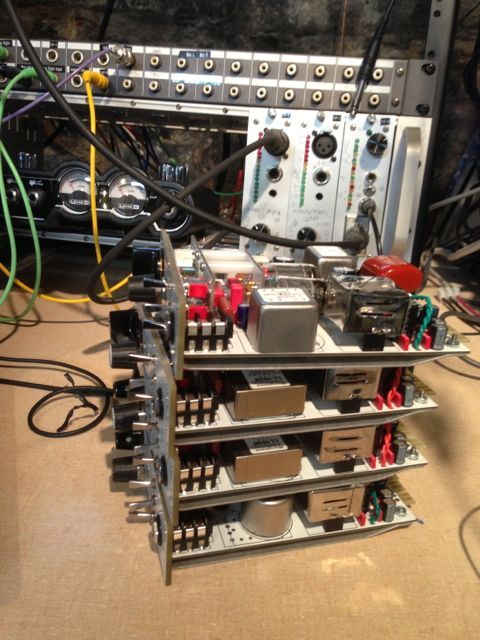
Lundahl In - Lundahl Out

OEP in OEP out
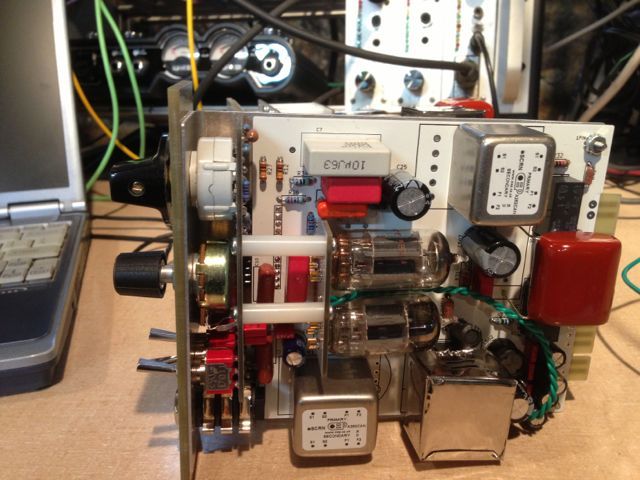
Cinemag In, OEP Out
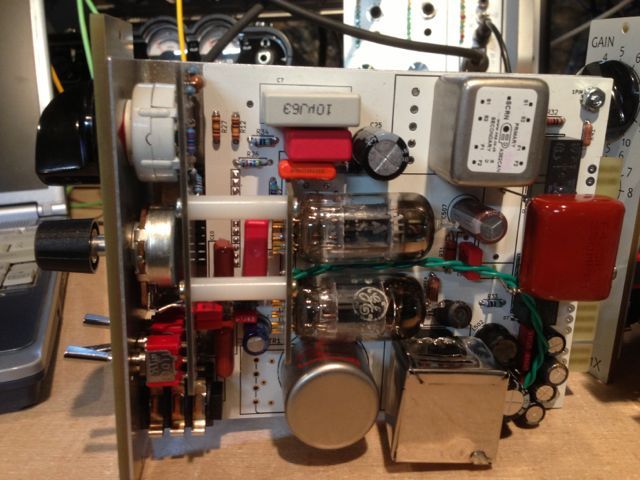
b
I am just using mumetal foil (cuts with scissors, very thin) much thinner than a tin can.
As I said, no measureable effect except for the Cinemag... and I think that is because of the position. Perhaps it is possible to order triple shields on the Cinemag... you can on Jensens... That would surely eliminate any issue.
I just don't get the rolloff differences related to the input trafo though. I think the OEP needs a zobel too. Want me to post some measured sweeps?
Currently I have 3 flavors, all of them are quiet. Here they are, and my test gear in the background.

Lundahl In - Lundahl Out

OEP in OEP out

Cinemag In, OEP Out

b
I can't hear the noise. It is -88.7db noise level vs -85.6 noise level (this test gear does not measure below -96dB or so, so the absolute numbers should be ignored, but the relative numbers show it is a minor issue.) If it was loud a human can't hear less than a 3dB difference, at -80 plus db... it is way in the noise.
The orientation of the trafo is tough. The circuit board has a place for pin 1... and there you go.
The orientation of the trafo is tough. The circuit board has a place for pin 1... and there you go.
mulletchuck
Well-known member
All this testing, and not a single person has actually used these preamps for recording since they finished their builds? COME ON PEOPLE!!! FOCUS ON WHAT MATTERS!!!!  ;D
;D
Similar threads
- Replies
- 8
- Views
- 642
- Replies
- 2
- Views
- 334

































